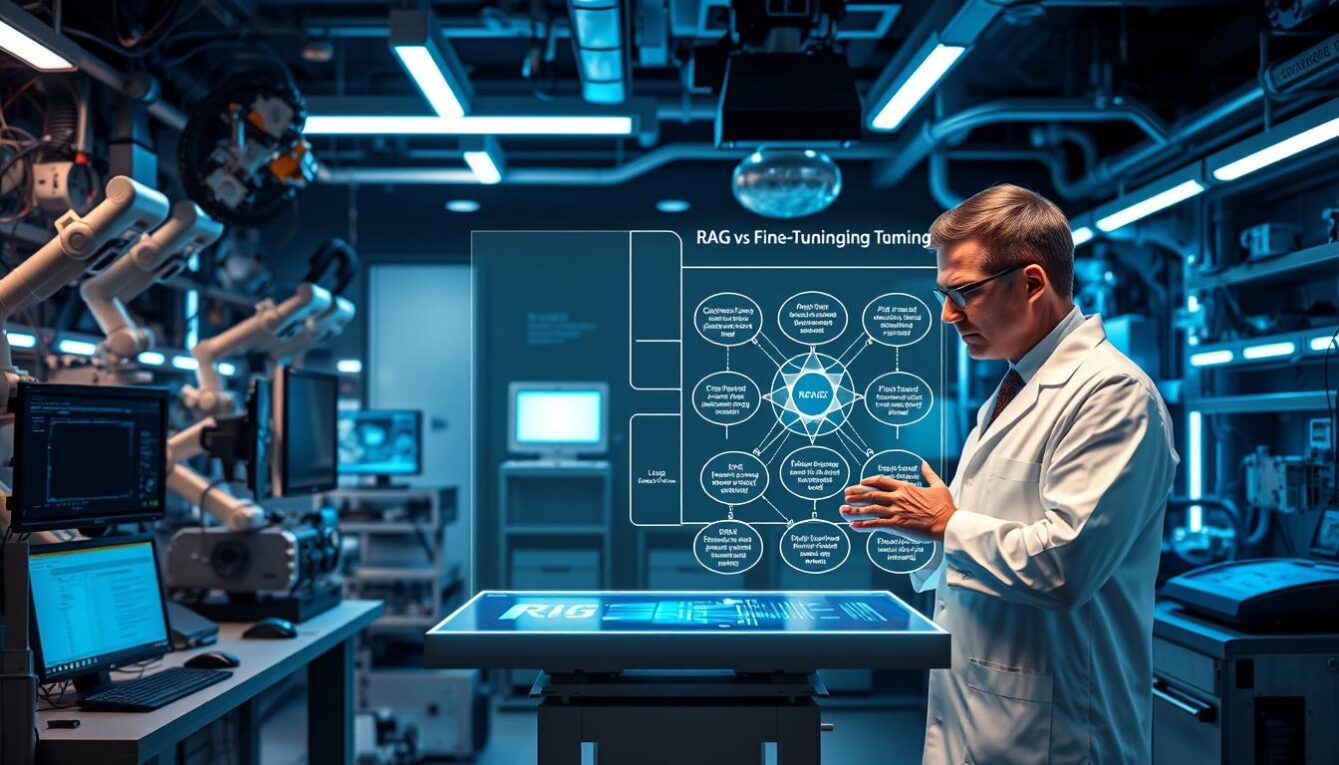Did you know that inefficient data processing can hurt RAG apps a lot? As someone who works with communication tech, I’ve seen how optimizing data processing steps helps RAG systems work better. I’ll show you the 6 key steps that really make a difference.

By following these steps, you can make your RAG app work much better. It’s all about smart ways to handle and process data.
Key Takeaways
- Understand the importance of data processing in RAG applications
- Learn the 6 crucial steps to enhance RAG performance
- Discover how to optimize data processing for better precision
- Implement practical strategies for RAG improvement
- Achieve significant enhancements in application performance
Understanding the RAG System
Retrieval-Augmented Generation (RAG) is a key technology in advanced data processing. It has a big impact on how we handle data. Let’s dive into what makes RAG special.
RAG is more than just a small step forward. It’s a big change in how we create and use data. It makes the data we get more accurate and useful.
What is RAG?
RAG combines two AI models into one. This mix lets RAG use lots of data from outside sources. This makes the data it creates more accurate and relevant.
RAG helps solve problems with old AI models. These models only use what they were trained on. RAG adds new info to make the data better.
How RAG Works
RAG works in two steps: it finds and uses data. First, it looks for the right info from a big database. Then, it uses this info to make the AI model’s output better.
RAG is great because it can use new info. This is very helpful when data changes a lot.
Benefits of RAG System
The RAG system has many good points. It makes data more precise and handles it better. This is key for tasks that need exact data.
| Benefit | Description | Impact |
|---|---|---|
| Enhanced Precision | RAG improves the accuracy of generated data by leveraging external knowledge sources. | High precision outputs |
| Improved Data Processing | RAG’s hybrid approach enables more efficient and effective data processing. | Better data handling |
| Increased Relevance | The retrieval-augmented generation process ensures that outputs are more contextually relevant. | More relevant outputs |
Knowing about RAG and its benefits helps us see its value. We’ll look into how to make it even better in the next parts.
Importance of Optimization in RAG
To get the most out of RAG, knowing how to optimize is key. Optimization ties together RAG’s parts, making data work better and more accurately.
Enhancing Data Processing
Boosting data processing needs several steps.
- Data Quality Improvement: It’s important to have clean, good data. This means cleaning and getting data ready well.
- Algorithmic Enhancements: Using smart algorithms for tough data is important. These help the system work better.
By working on these, RAG systems can process data much better. This makes them work better overall.
Increasing Efficiency
Making RAG systems work faster is about making things smoother and removing blocks.
- Process Automation: Making tasks automatic can cut down on time needed.
- Resource Optimization: Using computer resources well is key. This means adjusting resources as needed and making code better.
Improving Accuracy
Getting data right is the most important part of making RAG better.
- Precision in Data Processing: It’s all about getting data right. This means good algorithms and high-quality data.
- Continuous Monitoring: Keeping an eye on how well the system works and tweaking it is key for keeping accuracy high.
| Optimization Strategy | Impact on RAG System |
|---|---|
| Data Quality Improvement | Enhances accuracy and reliability |
| Process Automation | Increases efficiency and reduces processing times |
| Algorithmic Enhancements | Improves data processing capabilities and accuracy |
By focusing on these areas, companies can make their RAG systems work better. This leads to smarter decisions and more efficient work.
Step1: Data Collection Techniques
The first step to improve RAG is to collect good data. This is key for any RAG system. It makes sure the system works well.
Sources for Data Gathering
Finding the right places to get data is important. These places can be different for each RAG system. Some common places include:
- Internal databases and data warehouses
- Public datasets and repositories
- Web scraping and crawling
- User-generated content and feedback
Each place has its own good and bad points. For example, internal databases give structured data. But web scraping gives a lot of unstructured data that needs more work.
Tools for Efficient Collection
To get data well, you need the right tools. Some top tools for getting data are:
| Tool | Description | Use Case |
|---|---|---|
| Apache NiFi | Data integration tool for managing and processing data flows | Real-time data ingestion and processing |
| Scrapy | Python framework for web scraping | Extracting data from websites |
| AWS Glue | Fully managed extract, transform, and load (ETL) service | Data preparation and loading for analytics |
A top data scientist says, “Choosing the right tool for getting data is very important for your RAG system.”
“Data is the lifeblood of any AI system. Without high-quality data, even the most sophisticated algorithms will fail to deliver.”
Knowing where to get data and using the right tools is key. It makes your RAG system better and more efficient. It also makes the data processing easier.
Step2: Data Cleaning Methods
To get precise data, we must clean it well. Cleaning data makes sure it’s good and reliable for RAG systems. It fixes mistakes, making the system work better and more accurately.
Identifying Errors
Finding errors in data is the first step. Mistakes come from data entry errors, system bugs, or formatting issues. We use strong checks and data profiling to find these mistakes.
Data profiling checks data for patterns and mistakes. It shows us where the data is bad. We use summary stats and data visuals to understand the data better.
| Error Type | Description | Detection Method |
|---|---|---|
| Data Entry Mistakes | Typographical errors or incorrect data entry | Validation checks, data profiling |
| System Glitches | Errors caused by system or software failures | Data logging, error tracking |
| Inconsistent Formatting | Variations in data formatting | Data standardization, formatting checks |
Strategies for Data Cleansing
After finding errors, we clean the data. Cleaning means fixing or removing bad data. Key methods include:
- Data normalization: Making sure data looks the same.
- Data validation: Checking data against rules.
- Data deduplication: Getting rid of duplicate records.
These methods make data better, leading to accurate insights and smart decisions. Cleaning data is a never-ending task that needs constant work.
In short, cleaning data is key for RAG systems to work well. Knowing how to find and fix errors helps keep data reliable and trustworthy.
Step3: Data Transformation Essentials
We’re getting to the important part of RAG data processing. This is where we make data ready for RAG systems. We turn raw data into something we can use.
Importance of Data Formatting
Data formatting is key in data transformation. It makes sure data works well with RAG systems. Good data formatting cuts down on mistakes and makes systems work better.
Keeping data in the same format helps keep it accurate. It also makes sure data fits well with other sources. This makes the insights from RAG systems more reliable.
Techniques for Transformation
There are many ways to change data for better use. Here are a few:
- Data normalization: makes numbers the same size so they don’t mess up analysis.
- Data aggregation: puts many data points together into one to make things simpler.
- Data encoding: turns words into numbers so machines can understand them.
Using these methods makes your data better. This leads to better results and more accurate insights from your RAG system.
Step4: Implementing Machine Learning
Now, we’re into the fourth step of making RAG systems better. Machine learning plays a big role here. It helps RAG systems get smarter by learning from data and adjusting to new stuff.
To make machine learning work well, we need to pick the right algorithms and train them right. These steps are key to making RAG systems perform well.
Selecting the Right Algorithms
Choosing the right algorithm is very important. Each algorithm is good for different tasks and types of data.
- Supervised Learning Algorithms work best when data is labeled. They learn from labeled data.
- Unsupervised Learning Algorithms are for data without labels. They find patterns on their own.
- Reinforcement Learning Algorithms help models make decisions based on rewards or penalties.
Training Models Effectively
Training a model well is as important as picking the right algorithm. Here’s what to do:
- Data Preparation: Make sure the training data is clean and right.
- Hyperparameter Tuning: Adjust the model’s settings for the best performance.
- Model Evaluation: Check how well the model does on unseen data to avoid overfitting.
Here’s a quick guide to using machine learning in RAG systems:
| Aspect | Description | Importance |
|---|---|---|
| Algorithm Selection | Choosing an algorithm that fits the task and data type. | High |
| Data Quality | Ensuring the data used for training is accurate and relevant. | High |
| Hyperparameter Tuning | Adjusting model parameters for optimal performance. | Medium |
Step5: Analyzing Data Performance
Looking at data performance is key to making RAG systems better. It’s important to make sure the system works well.
To check data performance, we look at important metrics. These metrics help us see where the system can get better.
Metrics for Performance Evaluation
When we check a RAG system’s performance, we use precision, recall, and F1 score. Each metric gives us a different view of how well the system is doing.
| Metric | Description | Importance |
|---|---|---|
| Precision | Measures the accuracy of the system’s output | High precision means fewer wrong positives |
| Recall | Measures the system’s ability to capture relevant data | High recall means fewer wrong negatives |
| F1 Score | Harmonic mean of precision and recall | Shows a balance between precision and recall |
Interpreting Results
Understanding the results of data analysis is key. By looking at the metrics, we can see what’s working and what’s not.
A high precision score means the system is accurate. A high recall score means it’s catching the right data. The F1 score gives a full picture by combining both.
By studying these metrics and understanding the results, we can make the RAG system better. This leads to better performance, precision, and data analysis.
Step6: Continuous Monitoring and Adjustment
The sixth step in our RAG optimization journey is very important. It’s about keeping the system at its best by always watching and adjusting. I’ve learned that setting up the system is just the start. The real work is in keeping it running well over time.
Importance of Ongoing Evaluation
Checking the system often is key to finding problems early. By continuously monitoring the RAG system, you can catch changes fast. This helps keep the system working well and accurately.
Continuous watching has stopped big problems before they started. It keeps the system running smoothly. It’s all about staying alert and making changes when needed.
Best Practices for Adjustments
When making changes, there are smart ways to do it. First, know what the system’s goals are and how it measures up. This means:
- Looking at performance data often to spot trends and areas to get better.
- Using data-driven insights to guide change decisions.
- Making changes carefully to avoid big problems.
- Checking how changes affect the system to make sure they work.
By sticking to these best practices and focusing on performance optimization, your RAG system will stay in top shape. It will keep giving value for a long time.
Addressing Common Challenges in RAG
Using RAG systems well means solving technical and human problems. As more groups use RAG, it’s key to tackle these issues. This helps get the most out of it.
Technical Hurdles
One big tech problem is data quality and integrity. The data must be right, current, and useful. Also, adding RAG to current systems can be hard.
To beat these tech issues, focus on data validation and cleansing. A smart way to join systems can also help. This makes adding RAG easier.
Human Factors
But there’s more than tech to think about. User adoption and understanding are very important. How well users get along with RAG affects its success.
To deal with human issues, offer good training and support. This boosts user confidence. It also lets RAG systems work their best.
Future Trends in RAG System Optimization
The world of RAG system optimization is changing fast. New ideas are making things more precise and better. It’s important to keep up with these new things.
Advanced machine learning is a big deal. It helps the RAG system work better. Innovations in data processing also help a lot. They make data analysis quicker and more right.
Innovations in Data Processing
New tech in data processing is key for RAG system optimization’s future. Some big changes include:
- Improved ways to clean data, making it better and less wrong
- New ways to change data, making it easier to process
- Artificial intelligence to spot and stop data problems before they start
These new things make RAG systems work better. They also open up new ways to use them in different fields.
Predictions for the Industry
Looking into the future, we see some big changes coming. These changes will shape the RAG system optimization world. They include:
| Trend | Description | Impact |
|---|---|---|
| Increased Adoption of AI | More AI in data work and study | Things will get more efficient and right |
| Advancements in Machine Learning | New, smarter ML tools | Being able to predict things better |
| Greater Emphasis on Data Quality | More focus on good data | Decisions will be better and mistakes will go down |
As these changes keep coming, RAG system optimization will play an even bigger role. It will help businesses succeed and be more creative.
Case Studies of Successful RAG Implementation
Looking at case studies of RAG success gives us great insights. These examples show how RAG can work well. They also share the challenges and how to solve them.
Real-World Examples
Many companies have made RAG work for them. A big tech firm used RAG to get data faster. This made them 30% more efficient.
A bank also used RAG to guess risks better. This helped them make smarter choices.
These stories show RAG’s power in various fields. It helps companies work better, be more precise, and be creative.
Lessons Learned
These studies teach us important lessons. Data quality is key. Good data is essential for RAG to work well.
Choosing the right tools for your needs is also crucial. This makes RAG more useful.
Also, keeping an eye on RAG and making changes as needed is important. This helps it stay effective over time. Learning from these examples helps others use RAG wisely.
Tools and Technologies for RAG Optimization
RAG system optimization gets better with special tools and new tech. We’re always finding new ways to improve RAG systems. Knowing about tools and tech is key.
To make RAG systems better, we look at old and new tech. Old tech has its uses, but new tech brings new chances for better performance.
Software Recommendations
Many software tools lead in RAG optimization. They help with data and performance.
- Data Processing Tools: Tools like Apache NiFi and Talend help with big data in RAG systems.
- Performance Analysis Software: Grafana and Prometheus help watch and fix performance issues fast.
- Machine Learning Frameworks: TensorFlow and PyTorch are key for using machine learning in RAG systems.
A recent report says using advanced tools is key for RAG system success. It’s helped many industries.
“The right tools can make all the difference in optimizing RAG systems. It’s not just about processing power; it’s about the ability to analyze and act on data insights effectively.”
Emerging Technologies
New tech is changing RAG optimization. Many new techs are set to make big changes.
| Technology | Description | Potential Impact |
|---|---|---|
| Edge Computing | Processing data closer to its source | Reduced latency, improved real-time processing |
| Quantum Computing | Utilizing quantum-mechanical phenomena for computation | Exponential increase in processing power for complex models |
| Explainable AI (XAI) | Techniques to make AI decisions more transparent | Improved trust and reliability in RAG system outputs |

Getting Started with RAG System Optimization
Now we know how to make RAG systems better. It’s time to start using these tips. Making your RAG system better can make data work faster and more accurately. This means you’ll get more done in less time.
Initial Implementation Steps
First, find what needs to be better in your RAG system. Look at how you collect, clean, and change data. Then, start using the steps we talked about. Start with the most important ones first.
Recommended Resources for Further Learning
If you want to learn more, check out NVIDIA and Databricks. They have the latest ideas on making data work better. They help with making data and machine learning work smoother.
By starting with these steps and using good resources, you’ll get better at RAG system optimization. You’ll do data work faster and more accurately.










